Freedom of Navigation Monitoring
- All
- Russian Blood-Soaked Export
- Crimea Under Occupation
- Militarization of the Black Sea
- Freedom of Navigation Monitoring
- Sanctions
- Crimea Before Occupation
- Pre-War Archive
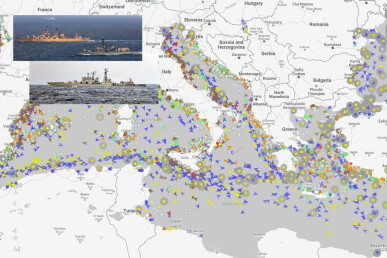
The Presence of Russian Warships in the Mediterranean Sea as of 15 September 2022
16 September 2022
In late summer of 2022, Russia began the rotation of part of its warships in the Mediterranean Sea. missile ships of the Northern Fleet, a reconnaissance ship of the Black Sea Fleet, 2 oil tankers of the Black Sea and Northern Fleets were withdrawn from the Mediterranean Sea. As of 15 September 2022, the confirmed composition of the Russian Navy squadron in the Mediterranean Sea includes 10 ships (7 of which are missile ships) and 4 auxiliary vessels. If another missile submarine is officially confirmed to be in the Mediterranean, the total number of ships will change from 10 to 11, and the number of missile ships will rise from 7 to 8.
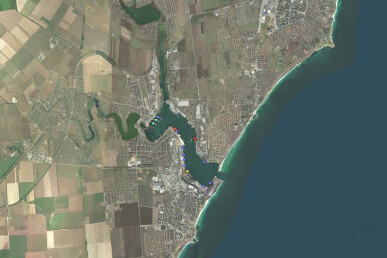
Blocked ships in Ukrainian ports during the war: The commercial sea port of Chornomorsk
31 July 2022
As of 24/02/2022, in the commercial sea port of Chornomorsk, in addition to port fleet vessels permanently based in Chornomorsk, there were 23 merchant ships. All of them have remained in port under blockade. Thus, out of 23 ships in the sea port of Chornomorsk, 6 belong to Turkish shipowners, 4 - to Ukrainian shipowners, 8 - to shipowners from the EU and the UK. Companies from Georgia, Japan, China, the UAE (in fact, Russia), and Liberia own one ship each.
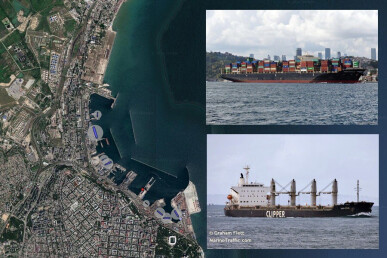
Blocked ships in Ukrainian ports during the war: The Odesa commercial sea port
27 July 2022
As of 24/02/2022, in the Odesa commercial sea port, in addition to port fleet vessels permanently based in Odesa, there were 9 merchant ships. All of them have remained in port under sea blockade. So, out of 9 ships in the sea port of Odesa, 2 belong to Turkish shipowners, 6 - to shipowners from EU countries - Germany and Greece, and one ship is owned by a company from Liberia.
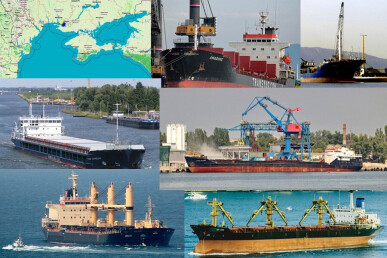
Blocked ships in Ukrainian ports during the war: The port of Kherson
24 June 2022
The Monitoring Group of the Black Sea Institute of Strategic Studies and BlackSeaNews wishes to bring to your attention a new series of articles about the fate of ships that were in Ukrainian ports on 24 February 2022, when Russia launched a full-scale invasion of many regions of Ukraine.
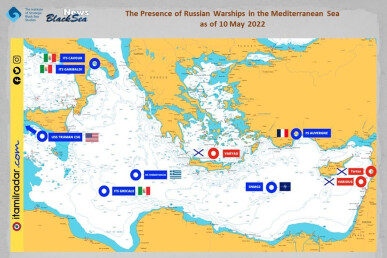
The Presence of Russian Warships in the Mediterranean Sea as of 10 May 2022
11 May 2022
As of 10 May 2022, the same naval group is present in the Mediterranean Sea as was on 7 February 2022 - i.e. no changes have taken place over the last 3 months. There are 13 ships and 5 support vessels of the four Russian fleets, including 9 attack missile ships. This situation is a consequence of Turkey’s decision, which was announced on 27 February 2022, to ban the passage through the straits of any warships, including ships of non-Black Sea NATO countries
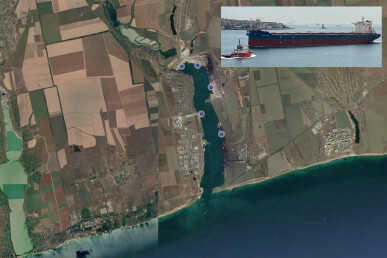
Blocked ships in Ukrainian ports during the war: the Pivdenny commercial sea port
11 May 2022
As of 24 February 2022, in the Pivdennyi commercial sea port (Yuzhne city, the Odesa region, Ukraine, international port code UA YUZ), in addition to port fleet vessels permanently based in the port, there were 9 merchant ships (See Table 1). All of them have remained in port under blockade. Thus, out of the 9 ships blocked in the Pivdennyi sea port, 6 belong to shipowners from EU countries, 3 - to shipowners from Japan.
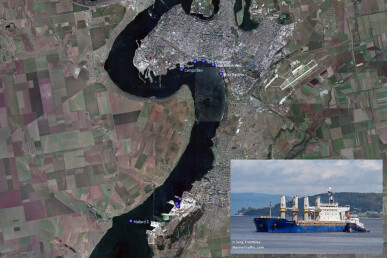
Ships blocked in Ukrainian ports during the war: The ports of the Mykolaiv region
10 April 2022
As of 24 February 2022, in the commercial sea ports of the Mykolaiv region (international port codes UA NLV MYKOLAIV, UA OCT OLVIA, UA NIKA TERA, UA DNB DNEPROBUGSKY), in addition to port fleet vessels permanently based there, there were 29 merchant ships (See Table 1). All of them have remained in port under blockade. Thus, out of the 29 ships blocked in the seaports of the Mykolaiv region as a result of Russia’s war against Ukraine, 13 belong to shipowners from EU+ countries and 16 - to shipowners from other countries.
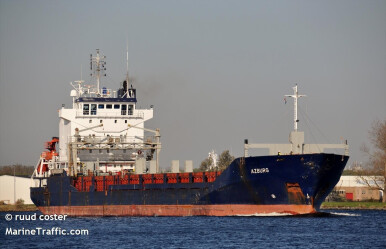
Blocked ships in Ukrainian ports during the war: The port of Mariupol
08 April 2022
The Monitoring Group of the Black Sea Institute of Strategic Studies and BlackSeaNews wishes to bring to your attention a new series of articles about the fate of ships that were in Ukrainian ports on 24 February 2022, when Russia launched a full-scale invasion of many regions of Ukraine.
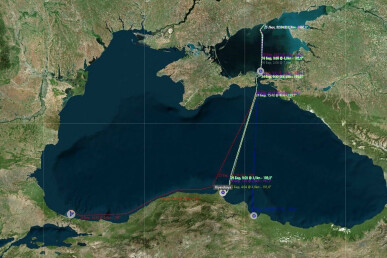
Blocked ships in Ukrainian ports during the war: The Berdiansk port
28 March 2022
The Monitoring Group of the Black Sea Institute of Strategic Studies and BlackSeaNews wishes to bring to your attention a new series of articles about the fate of ships that were in Ukrainian ports on 24 February 2022, when Russia launched a full-scale invasion of many regions of Ukraine. So, what is the fate of the ships that were at that time in the commercial seaport of Berdiansk?
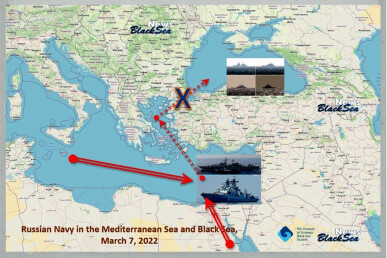
The Presence of Russian Warships in the Mediterranean Sea as of 9 March 2022
09 March 2022
The formation of a huge "Mediterranean Squadron" of the Russian Navy in February 2022, using the Northern, Baltic, and Pacific Fleets’ ships allowed the Russian Black Sea Fleet to return a large number of ships to the Black Sea a few days (weeks) before Russia’s attack on Ukraine. In addition, Russia redeployed 7 amphibious assault ships from the Mediterranean to the Black Sea, including 6 major amphibious assault ships of the Northern and Baltic Fleets. However, the fact that Russia has failed to redeploy additional powerful missile surface combatants to the Black Sea has called into question the effectiveness of a possible amphibious operation on the Ukrainian Black Sea coast.
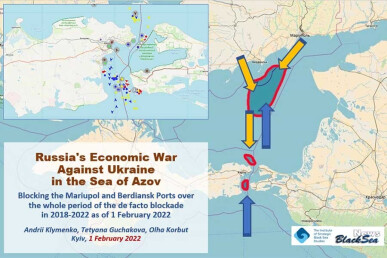
The Duration of Artificial Delays of Vessels in the Kerch Strait. The Monitoring for January 2022
16 February 2022
In January 2022, vessels carrying exports from Mariupol and Berdiansk were delayed at the exit from the Sea of Azov by the RF for an average of 60.6 hours. In 2019–2020, due to the threat of the "Azov package" of international sanctions, there was a slight decrease in the average duration of artificial delays of ships at the exit from the Sea of Azov to the Black Sea: in 2018 − 79.5 hours; in 2019 − up to 37.4; in 2020 − 29.6. In 2021, this figure increased significantly to 39.8 hours per vessel.
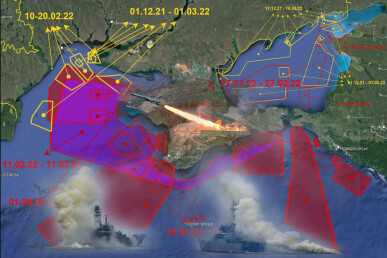
Increased Risks. Obstruction of Traffic in the Black and Azov Seas by Russia due to the Closure of Sea Areas for Military Exercises as of 15 February 2022
15 February 2022
This analytical review presents the results and conclusions made by the Monitoring Group of Black Sea Institute of Strategic Studies and the editorial board of BlackSeaNews based on monitoring in January-February 2022 the following area: Obstruction of traffic in the Black Sea and the Sea of Azov by the Russian Federation due to closures of sea areas for or under the pretext of military exercises.
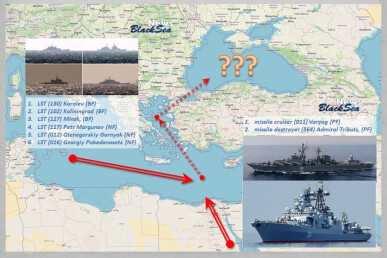
The Presence of Russian Warships in the Black Sea and the Mediterranean Sea in January 2022
01 February 2022
In January 2022, the number of Russian warships in the Mediterranean Sea changed dramatically. 6 major landing ships from the Baltic and Northern Fleets joined the "Mediterranean Squadron" of the Russian Federation. A missile cruiser and a missile frigate from the Pacific Fleet are expected to arrive via the Suez Canal. Thus, in February 2022, the Russian naval group in the Mediterranean Sea will have 18 major warships, including 8 missile ships (in December 2021, these figures were 8 and 5 respectively)
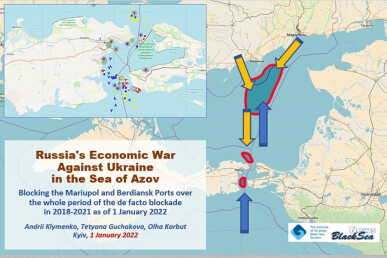
The Duration of Artificial Delays of Vessels in the Kerch Strait. The Monitoring for December 2021
05 January 2022
From December 2018 to December 2020, due to the threat of the "Azov package" of international sanctions against Russian ports on the Sea of Azov, there was a slight decrease in the average duration of artificial delays of ships at the exit from the Sea of Azov to the Black Sea: in 2018 − 79.5 hours; in 2019 − up to 37.4 hours; in 2020 − 29.6 hours per vessel. In 2021, this figure has increased significantly to 39.8 hours per vessel and already exceeded those for 2019 and 2020.
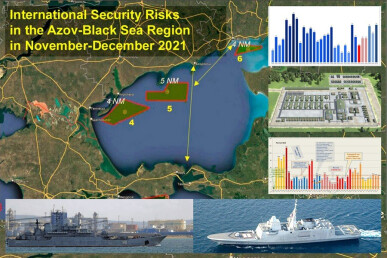
International Security Risks in the Azov-Black Sea Region in November-December 2021
20 December 2021
Russia is continuing to prepare for war. Increased obstruction of traffic in the Black Sea and the Sea of Azov has been recorded. The possibility of military action on the Ukrainian coast of the Sea of Azov, in particular airborne assault and amphibious operations, cannot be ruled out. The risk of Russian aggression will increase during the winter holidays and the Winter Olympics in China. The almost continuous presence in the Black Sea of powerful NATO missile ships is an effective deterrent to the aggressor.